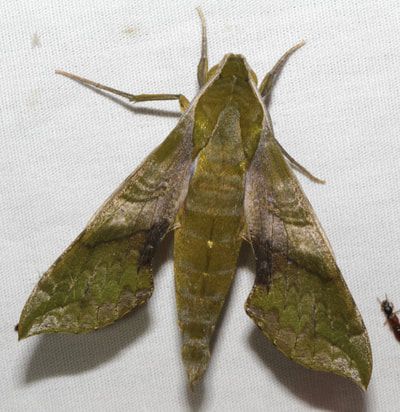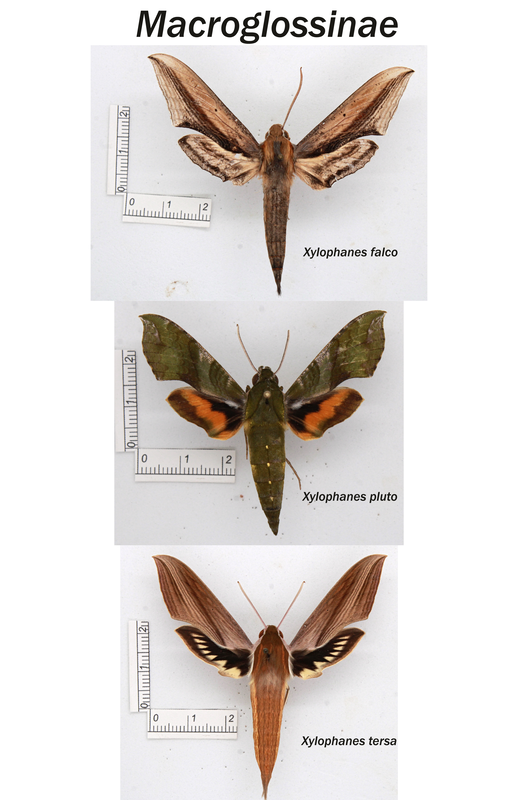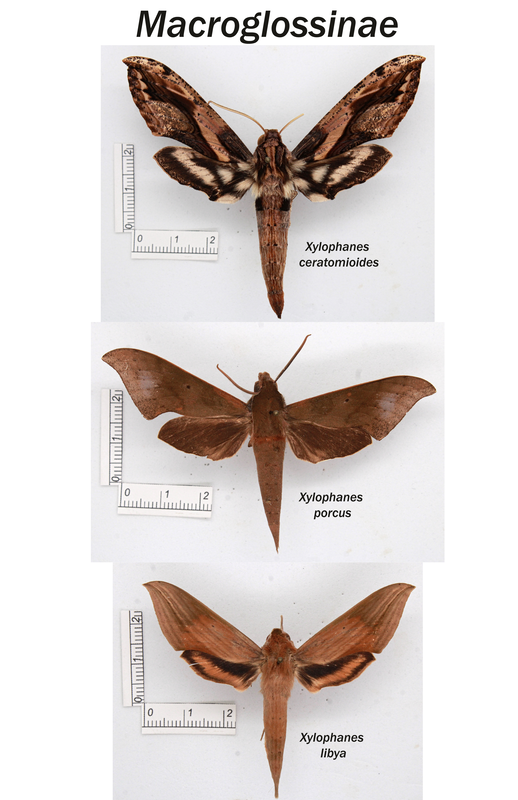The genus Xylophanes has 6 species in the USA, and 91 species distributed throughout the New-World.
Type specimen: Sphinx (Xylophanes) anubus - Cramer, (1777)
Synonyms: N/A
General Information: These are generally medium sized moths. The forewings are generally thin and streamlined. The hindwings often very well marked. The body is long and thin.
If you have narrowed something down to this genus, you can use this key to help you narrow down your search to species:
1: Forewings distinctly green with a white antemedial band. The thorax is green, and the hindwings are orange with a black edge and a black basal area… Xylophanes pluto
1’: Not as above (2)
2: Forewings brown with a greenish tint. The submarginal area is very pale and covered in thin black lines. The subterminal area is dark. The apex of the forewing is very hooked. The thorax is the same green-brown color as the wings with a distinctly gray middle area… Xylophanes falco
2’: Not as above (3)
3: The thorax is brown with two parallel orange stripes. The outer edge of the thorax is lined in white. The abdomen has orange coloration on the sides. Hindwings are black with distinctive yellow triangles… Xylophanes tersa
3’: Not as above (4)
4: Forewings flat, drab brown-gray color. Hindwings are brown. The thorax is brown-gray. There may be a black discal spot. A rare stray…. Xylophanes porcus
4’: Not as above (5)
5: The thorax is flat brown with no orange maculation. The forewings are flat, drab gray with a few white/black lines running from the base to the apex. The hindwings are black with an orange band. A rare stray… Xylophanes libya
5’: Very large moth. The forewings are cryptic looking. The costa and base of the forewings are black with a black streak through the middle. There is a light patch at the inner margin of the forewing. The hindwings are black with a white band and a white spot. A very rare stray… Xylophanes ceratomioides
Species List:
Xylophanes ceratomioides
Xylopanes falco
Xylophanes libya
Xylophanes porcus
Xylophanes tersa
Xylophanes pluto
The gallery below shows photos of select species in the genus.
Type specimen: Sphinx (Xylophanes) anubus - Cramer, (1777)
Synonyms: N/A
General Information: These are generally medium sized moths. The forewings are generally thin and streamlined. The hindwings often very well marked. The body is long and thin.
If you have narrowed something down to this genus, you can use this key to help you narrow down your search to species:
1: Forewings distinctly green with a white antemedial band. The thorax is green, and the hindwings are orange with a black edge and a black basal area… Xylophanes pluto
1’: Not as above (2)
2: Forewings brown with a greenish tint. The submarginal area is very pale and covered in thin black lines. The subterminal area is dark. The apex of the forewing is very hooked. The thorax is the same green-brown color as the wings with a distinctly gray middle area… Xylophanes falco
2’: Not as above (3)
3: The thorax is brown with two parallel orange stripes. The outer edge of the thorax is lined in white. The abdomen has orange coloration on the sides. Hindwings are black with distinctive yellow triangles… Xylophanes tersa
3’: Not as above (4)
4: Forewings flat, drab brown-gray color. Hindwings are brown. The thorax is brown-gray. There may be a black discal spot. A rare stray…. Xylophanes porcus
4’: Not as above (5)
5: The thorax is flat brown with no orange maculation. The forewings are flat, drab gray with a few white/black lines running from the base to the apex. The hindwings are black with an orange band. A rare stray… Xylophanes libya
5’: Very large moth. The forewings are cryptic looking. The costa and base of the forewings are black with a black streak through the middle. There is a light patch at the inner margin of the forewing. The hindwings are black with a white band and a white spot. A very rare stray… Xylophanes ceratomioides
Species List:
Xylophanes ceratomioides
Xylopanes falco
Xylophanes libya
Xylophanes porcus
Xylophanes tersa
Xylophanes pluto
The gallery below shows photos of select species in the genus.



